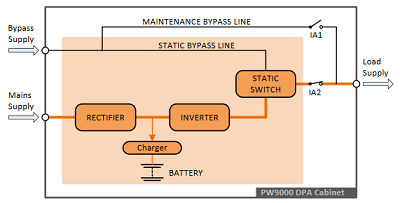In recent years the demand on computer-controlled real-time information systems has grown exponentially. The data centres that house these expect uncompromised reliability from their power supply as standard. The issue that matters above all is availability. This relationship between a power system’s uptime and its downtime is governed as much by its mean time to repair (MTTR) as its mean time between failures (MTBF).
Since their appearance in the 50s, UPS systems have provided reliable and clean power, with protection from the raw mains and a few minutes’ battery backup if the mains failed. The first systems comprised a rectifier, battery and inverter, with their reliability dominated by that of the inverter. In the early 60s, the situation was improved when static bypass switches were introduced.
These enabled an interruption-free load transfer to the standby mains if the inverter failed or overloaded. This early concept of redundancy significantly improved the overall reliability by reducing dependence on the inverter.
However the demand for computing power and the load imposed on data centres has increased so dramatically that these early configurations are no longer enough. Modern highly critical loads now use (n+1) redundant parallel UPS systems as standard. The kVA load specification is fully met by the n units, so the extra 1 unit provides redundancy.
At first glance, minimising the value of n appears to offer the best design, with fewest components and longest MTBF. However a (4+1) configuration actually provides better availability than a (1+1) system, if it is implemented using KOHLER PW hot swappable modules. Availability depends on MTTR as well as MTBF and critically, the modules allow an MTTR of just half an hour, compared with 6 hours for the traditional (1+1) UPS. Whereas the (1+1) availability is 0.9999952 (5 nines), the KOHLER PW (4+1) availability is 0.9999990 – at 6 nines, a very significant improvement.
A further benefit of the KOHLER PW (n+1) topography is that it can be rated more closely to the critical load specification, which reduces costs associated with over rated components and increases operational efficiency.




